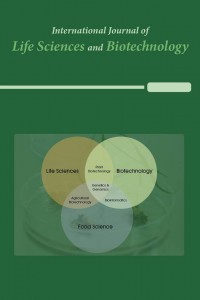ISOLATION AND CHARACTERISATION OF THE DEGRADATION POTENTIAL OF 2,2-DICHLOROPROPIONATE (2,2-DCP) BY BACILLUS AMYLOLIQUEFACIENS FROM GEBENG
ISOLATION AND CHARACTERISATION OF THE DEGRADATION POTENTIAL OF 2,2-DICHLOROPROPIONATE (2,2-DCP) BY BACILLUS AMYLOLIQUEFACIENS FROM GEBENG
Dehalogenase, α-halocarboxylic acid 16S rRNA, Biodegradation, 2, 2-DCP,
___
- Aguilera, F., Méndez, J., Pásaro, E., & Laffon, B. (2010). Review on the effects of exposure to spilled oils on human health. Journal of Applied Toxicology, 30(4), 291-301. https://doi.org/10.1002/jat.1521
- Alomar, D., Abdul Hamid, A. A., Khosrowabadi, E., Gicana, R. G., Lamis, R. J., Huyop, F., & Tengku Abdul Hamid, T. H. (2014). Molecular characterization of monochloroacetate-degrading Arthrobacter sp. Strain d2 isolated from Universiti Teknologi Malaysia agricultural area. Bioremediation Journal, 18(1), 12-19. https://doi.org/10.1080/10889868.2013.834867
- Altschul, S. F., Madden, T. L., Schäffer, A. A., Zhang, J., Zhang, Z., Miller, W., & Lipman, D. J. (1997). Gapped BLAST and PSI-BLAST: a new generation of protein database search programs. Nucleic acids research, 25(17), 3389-3402. https://doi.org/10.1093/nar/25.17.3389
- Ashton, F. M., & Crafts, A. S. (1973). Mode of action of herbicides. Mode of action of herbicides.
- Bergmann, J., & Sanik Jr, J. (1957). Determination of trace amounts of chlorine in naphtha. Analytical Chemistry, 29(2), 241-243. https://doi.org/10.1021/ac60122a018
- Chen, X.-H., Scholz, R., Borriss, M., Junge, H., Mögel, G., Kunz, S., & Borriss, R. (2009). Difficidin and bacilysin produced by plant-associated Bacillus amyloliquefaciens are efficient in controlling fire blight disease. Journal of Biotechnology, 140(1), 38-44. https://doi.org/10.1016/j.jbiotec.2008.10.015
- Chowdhury, S., Mishra, M., Adarsh, V., Mukherjee, A., Thakur, A. R., & Chaudhuri, S. R. (2008). Novel metal accumulator and protease secretor microbes from East Calcutta Wetland. American Journal of biochemistry and biotechnology, 3, 255-264. https://doi.org/10.3844/ajbbsp.2008.255.264
- Fravel, D. (2005). Commercialization and implementation of biocontrol 1. Annu. Rev. Phytopathol., 43, 337-359. https://doi.org/10.1146/annurev.phyto.43.032904.092924
- Fulton, C. K., & Cooper, R. A. (2005). Catabolism of sulfamate by Mycobacterium sp. CF1. Environmental Microbiology, 7(3), 378-381. https://doi.org/10.1111/j.1462-2920.2005.00719.x
- Hareland, W. A., Crawford, R. L., Chapman, P. J., & Dagley, S. (1975). Metabolic function and properties of 4-hydroxyphenylacetic acid 1-hydroxylase from Pseudomonas acidovorans. Journal of bacteriology, 121(1), 272-285. https://doi.org/10.1128/jb.121.1.272-285.1975
- Holt, J., Krieg, N., Sneath, P., & Staley, J. (1994). Bergey’s manual of determinative bacteriology Williams and Wilkins. Baltimore, MD, 527. https://doi.org/10.1002/pauz.19900190410
- Hughes, S. (1988). Microbial growth on 3-chloropropionic acid. University of Wales Institute of Science and Technology (UWIST).
- Huyop, F., & Nemati, M. (2010). Properties of dehalogenase from Rhizobium sp. RC1. African Journal of Microbiology Research, 4(25), 2836-2847. https://doi.org/10.1186/s40064-016-2328-9
- Kotan, R., Dikbas, N., & Bostan, H. (2009). Biological control of postharvest disease caused by Aspergillus flavus on stored lemon fruits. African Journal of Biotechnology, 8(2).
- Kumar, S., Stecher, G., & Tamura, K. (2016). MEGA7: Molecular Evolutionary Genetics Analysis version 7.0 for bigger datasets. Molecular biology and evolution, 33(7), 1870-1874.https://doi.org/10.1093/molbev/msw054
- Lamine Senghor, A., Liang, W.-J., & Ho, W.-C. (2007). Integrated control of Colletotrichum gloeosporioides on mango fruit in Taiwan by the combination of Bacillus s ubtilis and fruit bagging. Biocontrol science and technology, 17(8), 865-870. https://doi.org/10.1080/09583150701527409
- Leclère, V., Béchet, M., Adam, A., Guez, J.-S., Wathelet, B., Ongena, M., Jacques, P. (2005). Mycosubtilin overproduction by Bacillus subtilis BBG100 enhances the organism's antagonistic and biocontrol activities. Applied and Environmental Microbiology, 71(8), 4577-4584. https://doi.org/10.1128/aem.71.8.4577-4584.2005
- Medina‐Bellver, J. I., Marin, P., Delgado, A., Rodríguez‐Sánchez, A., Reyes, E., Ramos, J. L., & Marques, S. (2005). Evidence for in situ crude oil biodegradation after the Prestige oil spill. Environmental Microbiology, 7(6), 773-779. https://doi.org/10.1111/j.1462-2920.2005.00742.x
- Nübel, U., Garcia-Pichel, F., & Muyzer, G. (1997). PCR primers to amplify 16S rRNA genes from cyanobacteria. Applied and Environmental Microbiology, 63(8), 3327-3332. https://doi.org/10.1128/aem.63.8.3327-3332.1997
- Piggot, P. J., & Hilbert, D. W. (2004). Sporulation of Bacillus subtilis. Current opinion in microbiology, 7(6), 579-586. https://doi.org/10.1016/j.mib.2004.10.001
- Saitou, N., & Nei, M. (1987). The neighbor-joining method: a new method for reconstructing phylogenetic trees. Molecular biology and evolution, 4(4), 406-425. https://doi.org/10.1093/oxfordjournals.molbev.a040454
- Sathishkumar, M., Binupriya, A. R., Baik, S. H., & Yun, S. E. (2008). Biodegradation of crude oil by individual bacterial strains and a mixed bacterial consortium isolated from hydrocarbon-contaminated areas. CLEAN–Soil, Air, Water, 36(1), 92-96. https://doi.org/10.1002/clen.200700042
- Tiago, I., Teixeira, I., Si1va, S., Chung, P., Veríssimo, A., & Manaia, C. M. (2004). C
- Varsha, Y., Naga Deepthi, C., & Chenna, S. (2011). An emphasis on xenobiotic degradation in environmental cleanup. J Bioremed Biodegrad S, 11, 1-10. https://doi.org/10.4172/2155-6199.s11-001
- Wang, Y., Xin, Y., Cao, X., & Xue, S. (2015). Enhancement of L-2-haloacid dehalogenase expression in Pseudomonas stutzeri DEH138 based on the different substrate specificity between dehalogenase-producing bacteria and their dehalogenases. World Journal of Microbiology and Biotechnology, 31(4), 669-673. https://doi.org/10.1007/s11274-015-1817-2
- Yang, Z., Guo, H., & Zhang, X. (2008). Study on the control of peach post-harvest diseases using Bacillus subtilis. China Fruits, 23, 35-38.
- Yayın Aralığı: Yılda 3 Sayı
- Başlangıç: 2018
- Yayıncı: International Society of Academicians
Assessment of Food Safety During Covid-19 Pandemic
Cennet Pelin BOYACİ GUNDUZ, Mehmet Fatih CENGİZ
Çeşitli evsel atıkların Aureobasidium pullulans tarafından melanin sentezinde kullanılması
Cancer Suppression by Lymphocytes Activated by Cancer-Mediated Exosomes: an In Vitro Study
Aysegul YILMAZ, Irmak FERAH OKKAY, Ali TAGHİZADEHGHALEHJOUGHİ
Sk Injamamul ISLAM, Moslema Jahan MOU, Saloa SANJİDA, Md. SAROWER-E-MAHFUJ, Md. Ashraful ALAM, Yeasmin ARA
Firdausi ALİYU, Aliyu ADAMU, Roswanira AB. WAHAB, Fahrul ZAMAN HUYOP
Hatice Aysun MERCİMEK TAKCI, Sema GENÇ, Ayşenur YALÇIN, Eda ÖZDEMİR
Plant Attractants and Rewards for Pollinators: Their Significant to Successful Crop Pollination
Nur Athirah ZARİMAN, Nurul Alia OMAR, A. NURUL HUDA
